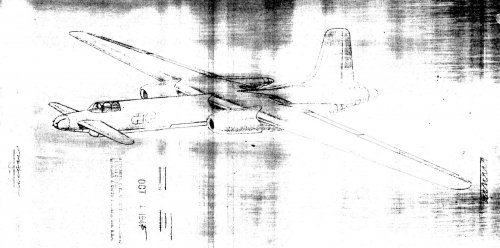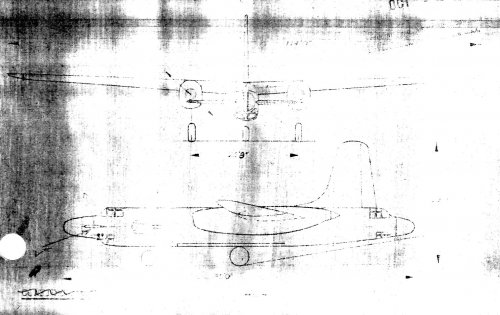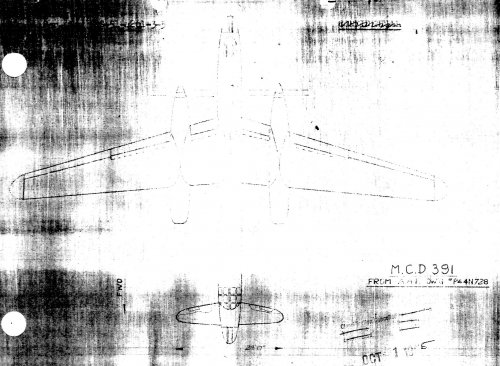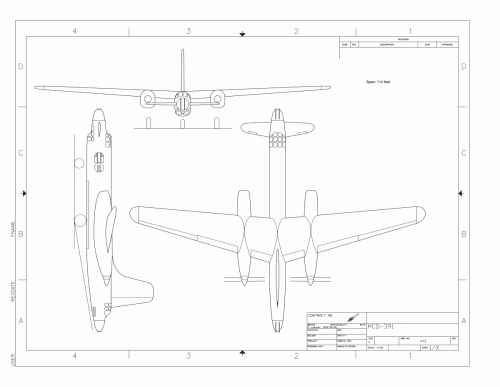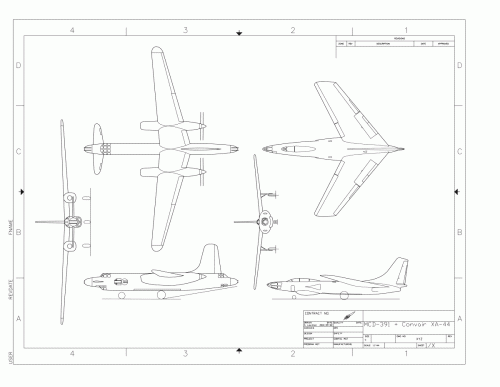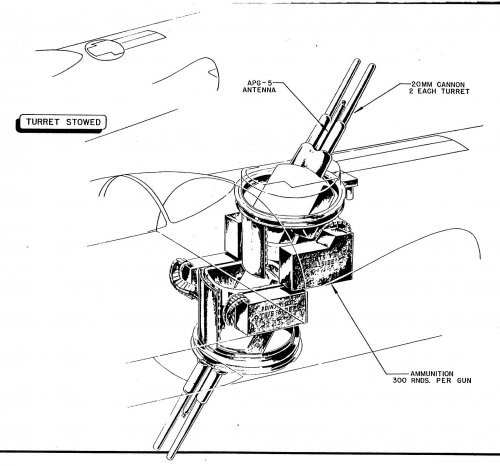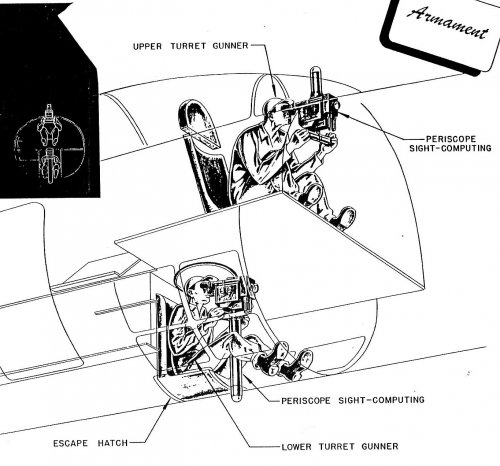In posting on AMC's super-heavy bomber analysis (posted as MCD 392), I had raised the question 'does anyone have anything on AMC's internal design series designations?' In passing, I mentioned a folder on XA-44/XB-53 (more to post separately on that topic) because I'd remembered that it contained another AMC design. Here it is: MCD 391, also created under the MX-423 umbrella, as per the markings on the covering Engineering Division Memorandum Rpt (ENG-51-4261-3-3) dtd 21 February 1944. (Note, by the way that it precedes the MCD 392 analyses by 3-4 months. The memo also says that MCD 391's characteristics were meant to "conform with the requirements of a specification for medium bombers [Spec. No. X-1803A], similar to those for Material Command Design No. 372.") The design was predicated on two Allison V-3420 engines and a gross weight of 65,000 lbs., resulting in a maximum speed of 381 mph at 35,000 using military engine power. The range for a 4,000 lb bomb load at that gross weight was expected to be 4,400 miles at an altitude of 10,000 feet. The memo recommended that a wind tunnel model be built and tested. Anyone find anything thus far that looks like this? [Very sorry for the copy quality -- it's an OLD xerox. The original is in NARA RG 342, box 2178.]
You are using an out of date browser. It may not display this or other websites correctly.
You should upgrade or use an alternative browser.
You should upgrade or use an alternative browser.
AAF Materiel Command Design MCD 391 (MX-423)
- Thread starter Clioman
- Start date
Oh, yeah, THAT's the stuff. Thanks!
Drawings like this are terrible for republication, but great for re-drawing. I'll give it a shot.
PS: what's the span? I can read 114 feet, but not the inches.
Drawings like this are terrible for republication, but great for re-drawing. I'll give it a shot.
PS: what's the span? I can read 114 feet, but not the inches.
I'm fairly sure that it reads 114'0". Of additional interest is the comment as to why AMC thought that forward sweep was worth considering in an obviously sub-sonic design: "1. By using the swept forward wing it is possible to use a tapered wing without getting the tip stall characteristics found in tapered wings. By sweeping the wing forward the effect is equivalent to decreasing the taper ratio of the wing. 2. the horizontal control surface is not blanketed when the wing flaps are extended as sometimes occurs with conventional airplanes."
Scott, if you redraw this, you'll repost, yes?
Scott, if you redraw this, you'll repost, yes?
Clioman said:Scott, if you redraw this, you'll repost, yes?
No. I refuse. Absolutely not. No way. No how. Nuh-uh.
Here you go.
Attachments
- Joined
- 11 March 2006
- Messages
- 8,610
- Reaction score
- 3,070
Thanks Scott, well done ! 
Am I wrong, or was a new concept for the armament supposed ?
The lateral turrets lying flush in the fuselage sides and the nose and
tail turrets remind me on the arrangement tested later with a Grumman
Panther, I think. Was such an armament ever tested before ?
Am I wrong, or was a new concept for the armament supposed ?
The lateral turrets lying flush in the fuselage sides and the nose and
tail turrets remind me on the arrangement tested later with a Grumman
Panther, I think. Was such an armament ever tested before ?
Jemiba said:Thanks Scott, well done !
Thanks!
If anyone wants to do a color version, I can made the DWG file available to 'em.
Am I wrong, or was a new concept for the armament supposed ?
It's clearly the same sort of turret as the F9F turret. I'm unschooled on the chronology of the technology, I'm afraid.
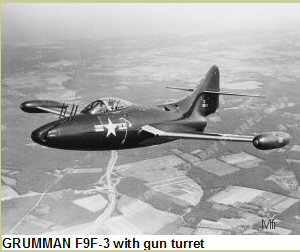
It's clearly the same sort of turret as the F9F turret.
I'm not so sure. We're looking at two different arrangements: the nose and tail turret may have been similar. There was an effort akin to the Panther arrangement projected for the Curtiss XP-87 and/or Northrop F-89 (but AFAIK, not actually flown) under AMC's MX-769, and possibly linked with something called Project Mallet. The idea was that the entire nose would be rotatable, so that the gun battery could be slewed to track targets well off the axis of flight. But the drawings for MCD 391 pre-date this by well over a year or more.
As to the submersible turrets shown on MCD 391, something very much like this appeared in the subsequent XB-53 proposal. Here's an illustration of them taken from a Consolidated-Vultee XB-53 brochure (Rpt FZP-003) dtd 4-1-46:
Attachments
Clioman said:a Consolidated-Vultee XB-53 brochure (Rpt FZP-003) dtd 4-1-46:
HOLY CRAP. Gimme!!!!!
Please!
- Joined
- 25 June 2009
- Messages
- 13,789
- Reaction score
- 3,102
Omigod! Where on earth did you find this??Clioman said:Here's an illustration of them taken from a Consolidated-Vultee XB-53 brochure (Rpt FZP-003) dtd 4-1-46:
Hesham, I'm not sure if I understand your point. The AAF's Materiel Command had an administrative process for identifying and tracking its own internal design studies, as did the Navy's Bureau of Aeronautics; recent posts have identified examples of both systems' designs, e.g., MCD 392 and BuAer 124. AAFMC had an elaborate scheme for identifying its engineering studies and reports, and it linked those products to Specifications for requirements purposes, and to Expenditure Orders for funding obligation purposes. AAFMC also had an internal security system for identifying classified projects in correspondence w/o necessarily saying what the project was about, i.e., the MX system.
Contractors (or vendors, in government contract language) had separate systems of their own for similar reasons, and some of them were similarly elaborate. Consolidated-Vultee's internal designation system assigned model numbers to its aircraft programs, of course, but the company also had an analogous scheme for labeling reports and studies--in later years, to include an indicator as to whether the product was the result of efforts in San Diego or in Fort Worth -- its two major corporate locations. I believe that's where the ZP and FZP come from...
The last thing I want to do is to start a flame war, but I simply don't understand your determination to conflate or confuse all of these separate nomenclatures. In terms of designations, Consolidated-Vultee's Model 112, subsequently designated by the AAF as the XA-44/XB-53, had nothing to do with the preceding AMC design called MCD 391, just as the nomenclature of the Wright Field Engineering Division report I cited above had nothing to do with the prefix used by Convair in identifying a brochure it produced two years later. Or am I missing something entirely?
Contractors (or vendors, in government contract language) had separate systems of their own for similar reasons, and some of them were similarly elaborate. Consolidated-Vultee's internal designation system assigned model numbers to its aircraft programs, of course, but the company also had an analogous scheme for labeling reports and studies--in later years, to include an indicator as to whether the product was the result of efforts in San Diego or in Fort Worth -- its two major corporate locations. I believe that's where the ZP and FZP come from...
The last thing I want to do is to start a flame war, but I simply don't understand your determination to conflate or confuse all of these separate nomenclatures. In terms of designations, Consolidated-Vultee's Model 112, subsequently designated by the AAF as the XA-44/XB-53, had nothing to do with the preceding AMC design called MCD 391, just as the nomenclature of the Wright Field Engineering Division report I cited above had nothing to do with the prefix used by Convair in identifying a brochure it produced two years later. Or am I missing something entirely?
XP67_Moonbat
ACCESS: Top Secret
- Joined
- 16 January 2008
- Messages
- 2,246
- Reaction score
- 379
Clio! Will that brochure be available for sale? I have a PayPal account! 
XP67_Moonbat
ACCESS: Top Secret
- Joined
- 16 January 2008
- Messages
- 2,246
- Reaction score
- 379
Still standing by on that XB-53 brochure! 
- Joined
- 8 March 2009
- Messages
- 939
- Reaction score
- 924
XP67_Moonbat said:Still standing by on that XB-53 brochure!
I second this motion!
- Joined
- 2 January 2011
- Messages
- 334
- Reaction score
- 309
Clio,
At the very beginning of this thread you talked about MCD 392, Material Command's super-heavy bomber project.
Over the years I have gathered as much as I could about super-heavy bomber projects at that time and some very interesting post-war designs, too.
In your post you state that the drawings are/were in RG342 Box2178 Engineering Division Memorandum Rpt (4261-3-4, dtd 12 May 44, and 4261-3-5, dtd 29 Jun 44). Can you tell me which subcategory of RG342 they were in, i.e. P26/P27/P28/P29 or other? And do you happen to know where the MCD designs are kept? I have more on fighters and observation aircraft than I need at present, but am looking for data on all their 4-engine (or more) bomber projects from about 1934 on. A number of the early ones have been misidentified with various manufacturers of the time due to MCD practices. I think I've got those all sorted out, including wind-tunnel model photographs.
Can you help me the items above? I don't know when or if my physical condition will allow me to go to NARA again, but if I am able I doubt I will be able to do more than two days. Not like the time I spent three straight months out there! In the meantime I'm going through bomber projects to find the one that matches up with MCD 391. I believe it is either Lockheed or Douglas. As for HSB-61, it reminds me greatly of the Consolidated tailless bomber designs. I'm trying to determine if there was any relationship there or fortuitous accident.
I appreciate any assistance.
My email is ag122651 at hotmail dot com
Thanks!
AlanG
At the very beginning of this thread you talked about MCD 392, Material Command's super-heavy bomber project.
Over the years I have gathered as much as I could about super-heavy bomber projects at that time and some very interesting post-war designs, too.
In your post you state that the drawings are/were in RG342 Box2178 Engineering Division Memorandum Rpt (4261-3-4, dtd 12 May 44, and 4261-3-5, dtd 29 Jun 44). Can you tell me which subcategory of RG342 they were in, i.e. P26/P27/P28/P29 or other? And do you happen to know where the MCD designs are kept? I have more on fighters and observation aircraft than I need at present, but am looking for data on all their 4-engine (or more) bomber projects from about 1934 on. A number of the early ones have been misidentified with various manufacturers of the time due to MCD practices. I think I've got those all sorted out, including wind-tunnel model photographs.
Can you help me the items above? I don't know when or if my physical condition will allow me to go to NARA again, but if I am able I doubt I will be able to do more than two days. Not like the time I spent three straight months out there! In the meantime I'm going through bomber projects to find the one that matches up with MCD 391. I believe it is either Lockheed or Douglas. As for HSB-61, it reminds me greatly of the Consolidated tailless bomber designs. I'm trying to determine if there was any relationship there or fortuitous accident.
I appreciate any assistance.
My email is ag122651 at hotmail dot com
Thanks!
AlanG
Last edited:
- Joined
- 11 March 2012
- Messages
- 3,016
- Reaction score
- 2,698
Those periscope-equipped gunners' stations remind us of the periscope-sighted FN-64 turrets mounted in the bellies of early Avro Lancaster bombers. Those RAF Bomber Command periscopes only had a 20 degree arc of observation and the turrets turned too slowly to track interceptors. Those FN-64 turrets were soon deleted as a loss of pay-load.Hesham, I'm not sure if I understand your point. The AAF's Materiel Command had an administrative process for identifying and tracking its own internal design studies, as did the Navy's Bureau of Aeronautics; recent posts have identified examples of both systems' designs, e.g., MCD 392 and BuAer 124. AAFMC had an elaborate scheme for identifying its engineering studies and reports, and it linked those products to Specifications for requirements purposes, and to Expenditure Orders for funding obligation purposes. AAFMC also had an internal security system for identifying classified projects in correspondence w/o necessarily saying what the project was about, i.e., the MX system.
Contractors (or vendors, in government contract language) had separate systems of their own for similar reasons, and some of them were similarly elaborate. Consolidated-Vultee's internal designation system assigned model numbers to its aircraft programs, of course, but the company also had an analogous scheme for labeling reports and studies--in later years, to include an indicator as to whether the product was the result of efforts in San Diego or in Fort Worth -- its two major corporate locations. I believe that's where the ZP and FZP come from...
The last thing I want to do is to start a flame war, but I simply don't understand your determination to conflate or confuse all of these separate nomenclatures. In terms of designations, Consolidated-Vultee's Model 112, subsequently designated by the AAF as the XA-44/XB-53, had nothing to do with the preceding AMC design called MCD 391, just as the nomenclature of the Wright Field Engineering Division report I cited above had nothing to do with the prefix used by Convair in identifying a brochure it produced two years later. Or am I missing something entirely?
We wonder how the later - proposed - USAF periscopes improved upon the RAF pattern.
Did USAF periscopes have variable arc of observation?
Similar threads
-
AAF Materiel Command Design MCD 392 (MX-423)
- Started by Clioman
- Replies: 43
-
Consolidated-Vultee XA-44 (MX-423 and MX-716)
- Started by Clioman
- Replies: 8
-
-
MX (Peacekeeper) deployment concepts.
- Started by sferrin
- Replies: 292
-

